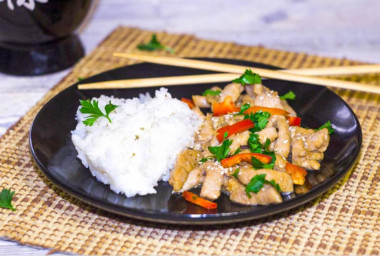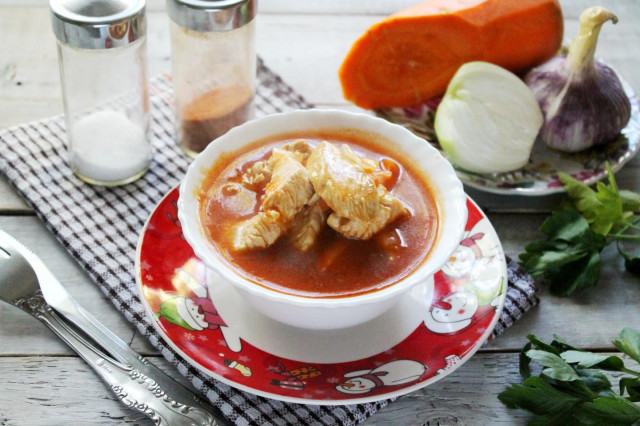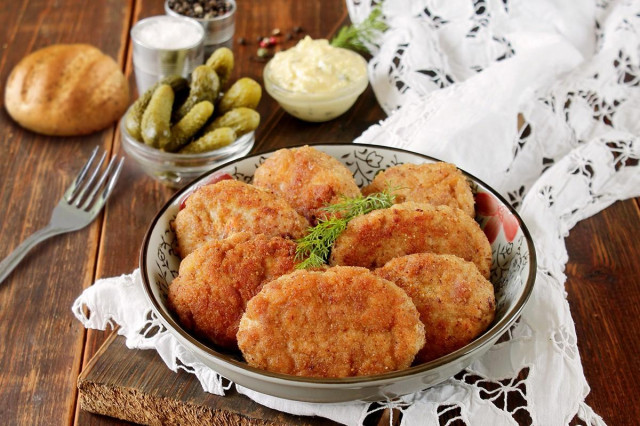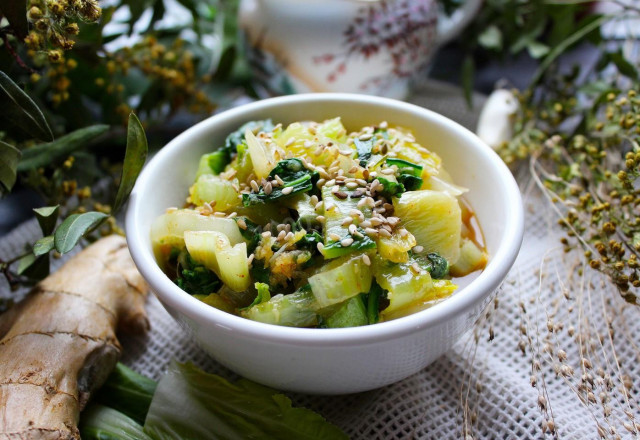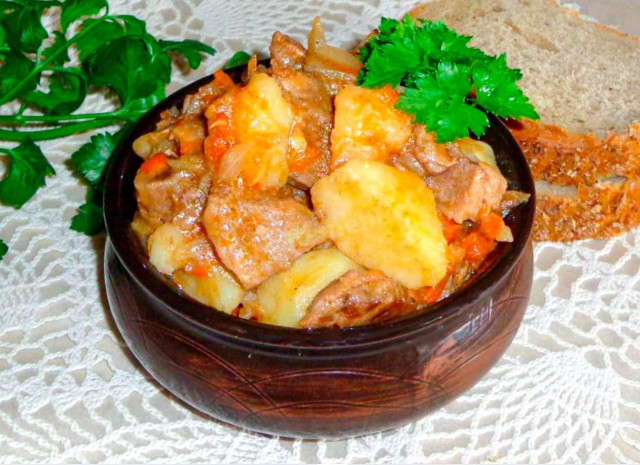Composition / ingredients
Step-by-step cooking
Step 1:
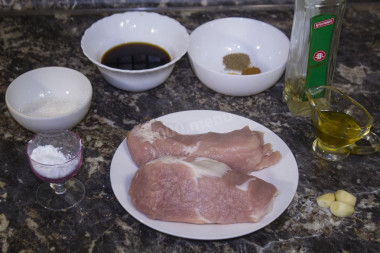
How to make Korean meat with pepper? Prepare the necessary ingredients. Which part of pork should I choose? For this dish, take the best meat, such as pork tenderloin. If the meat has been frozen, defrost it by transferring it from the freezer to the bottom shelf of the refrigerator in advance.
Step 2:

Wash the pork, dry it with paper towels. Cut into slices (about 1.5-2 cm thick) and lightly beat off on both sides with a kitchen hammer. To prevent splashes from flying from the meat, cover it with cling film and beat it right through it.
Step 3:
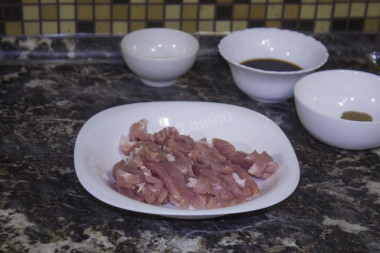
Chop the chopped meat slices thinly across the fibers into strips. The thinner you cut it, the faster it will fry.
Step 4:
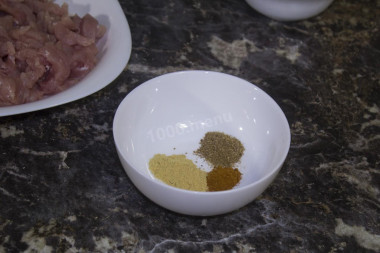
How to make marinade? Pour the dried ginger, coriander and red hot pepper into a small container.
Step 5:
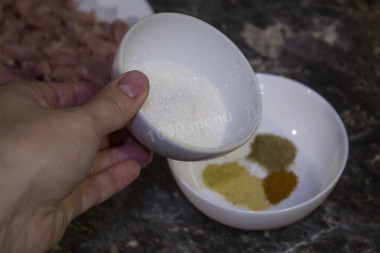
Add sugar and potato starch. If you use corn starch, its amount should be doubled.
Step 6:

Mix the dry ingredients.
Step 7:
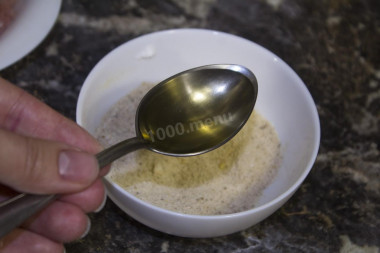
Pour in the rice vinegar.
Step 8:

Add soy sauce.
Step 9:
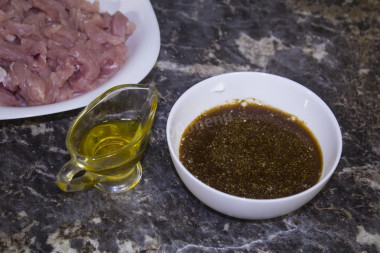
Add some sesame oil.
Step 10:
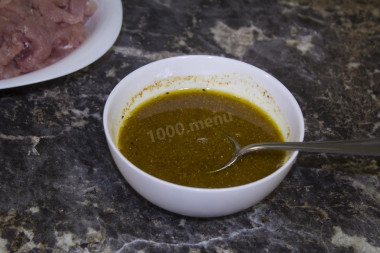
Stir with a spoon. The marinade is ready!
Step 11:

Pour the marinade over the pork pieces. Stir so that it is evenly distributed throughout the meat. Leave the pork to marinate at room temperature for 20 minutes. If time permits, put it in the refrigerator overnight, then the meat will be softer and juicier.
Step 12:

Pour vegetable oil into a non-stick frying pan (you can use a wok). Warm it up well. It is better to fry the meat in small portions in two sets, so the meat is better fried and well browned. Lay out so much pork that it covers the bottom of the pan in one layer. Fry it for 3-4 minutes on medium heat, stirring. Transfer the finished meat to a plate and fry the next portion. So overcook all the pork.
Step 13:
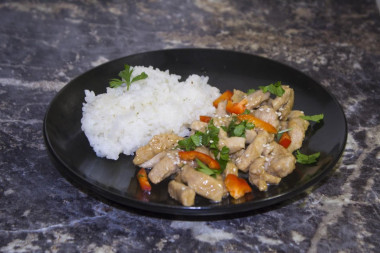
Put the finished meat on plates. Sprinkle on top with coarsely chopped parsley or green onions, red pepper – sweet or spicy, as you prefer. Pre-cut the bell pepper in half, peel off the stalk and seeds, cut into strips and lightly fry. If you like, sprinkle the meat with sesame seeds, lightly fried until golden in a dry frying pan.
Step 14:

Serve crumbly rice and vegetables as a side dish. Bon appetit!
You can add onion sliced into thin half rings to the marinade.
In addition to pork, any other meat can be used in this dish. Keep in mind that the cooking time, as well as the taste and calorie content of the dish will change. For example, beef is cooked longer than pork, and chicken fillet or turkey is less.
Since the degree of salinity, sweetness, bitterness, sharpness, acid, burning is individual for everyone, always add spices, spices and seasonings, focusing on your taste! If you put some of the seasonings for the first time, then keep in mind that there are spices that it is especially important not to shift (for example, chili pepper).
Use oil with a high smoking temperature for frying! Any oils are useful only until a certain temperature is reached - the point of smoking, at which the oil begins to burn and toxic substances, including carcinogens, are formed in it.
Unrefined oils, with rare exceptions, have a low smoking point. There are a lot of unfiltered organic particles in them, which quickly begin to burn.
Refined oils are more resistant to heating, and their smoking point is higher. If you are going to cook food in the oven, on a frying pan or grill, make sure that you use oil with a high smoking point. The most common of the oils with a high smoking point: refined varieties of sunflower, olive and grape.
You can check whether the oil has warmed up well enough in a frying pan in a simple way. Lower a wooden spatula into it. If bubbles have gathered around it, then you can start the frying process.
Caloric content of the products possible in the composition of the dish
- Pork fat - 333 kcal/100g
- Pork meat - 357 kcal/100g
- Pork - low-fat roast - 184 kcal/100g
- Pork chop on a bone - 537 kcal/100g
- Pork - schnitzel - 352 kcal/100g
- Pork shoulder - 593 kcal/100g
- Boar's leg - 113 kcal/100g
- Pork - 259 kcal/100g
- Sweet pepper - 27 kcal/100g
- Ginger - 80 kcal/100g
- Dry ginger - 347 kcal/100g
- Pickled ginger - 51 kcal/100g
- Parsley greens - 45 kcal/100g
- Soy sauce - 51 kcal/100g
- Granulated sugar - 398 kcal/100g
- Sugar - 398 kcal/100g
- Starch - 320 kcal/100g
- Vegetable oil - 873 kcal/100g
- Dried whole sesame seeds - 563 kcal/100g
- Shelled sesame seed - 582 kcal/100g
- Ground red pepper - 318 kcal/100g
- Rice vinegar - 20 kcal/100g
- Ground coriander - 25 kcal/100g
- Sesame oil - 899 kcal/100g


